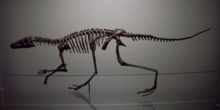| Lagosuchus Temporal range: Late Triassic,
| |
|---|---|

| |
| Mounted skeleton (based on specimens previously referred to Marasuchus) | |
| Scientific classification | |
| Domain: | Eukaryota |
| Kingdom: | Animalia |
| Phylum: | Chordata |
| Clade: | Ornithodira |
| Clade: | Dinosauromorpha |
| Order: | †Lagosuchia Paul, 1988 |
| Family: | †Lagosuchidae Bonaparte, 1975 |
| Genus: | †Lagosuchus Romer, 1971 |
| Species: | †L. talampayensis
|
| Binomial name | |
| †Lagosuchus talampayensis Romer, 1971
| |
| Synonyms | |
| |
Lagosuchus is an extinct genus of avemetatarsalian archosaur from the Late Triassic of Argentina. The type species of Lagosuchus, Lagosuchus talampayensis, is based on a small partial skeleton recovered from the early Carnian-age Chañares Formation. The holotype skeleton of L. talampayensis is fairly fragmentary, but it does possess some traits suggesting that Lagosuchus was a probable dinosauriform, closely related to dinosaurs.[1][2][3]
A second potential species of Lagosuchus, L. lilloensis, is based on an assortment of slightly larger and more well-preserved fossils.[4] These larger specimens have been considered much more diagnostic and informative than the original small L. talampayensis skeleton. As a result, some paleontologists have placed the larger specimens into a new genus, Marasuchus. Marasuchus is generally considered one of the more complete early dinosauriforms, useful for estimating ancestral traits for the origin of dinosaurs. This would also render Lagosuchus a nomen dubium, simply a name referring to a fossil which is too fragmentary to have a formal genus.[2][5] However, other paleontologists support the argument that Lagosuchus is a valid genus, and that Marasuchus is a junior synonym of it.[6][3]
- ^ Cite error: The named reference
:1was invoked but never defined (see the help page). - ^ a b Cite error: The named reference
:0was invoked but never defined (see the help page). - ^ a b Cite error: The named reference
Agnolin19was invoked but never defined (see the help page). - ^ Cite error: The named reference
:2was invoked but never defined (see the help page). - ^ Cite error: The named reference
nesbitt2011was invoked but never defined (see the help page). - ^ Cite error: The named reference
:3was invoked but never defined (see the help page).